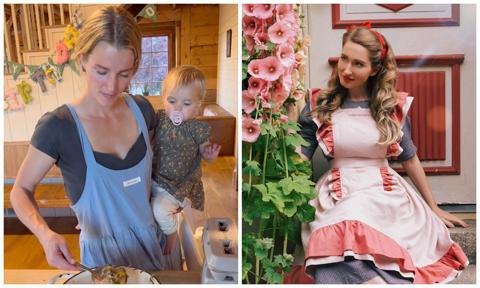
In the fast-paced world of social media, trends come and go like fleeting gusts of wind. However, one trend seems to have dug its heels firmly into the digital landscape: the rise of the ‘Tradwife’ phenomenon. With hashtags like #tradwife racking up millions of views on TikTok, it’s time to unravel the allure, controversies and implications of this modern twist on retro domesticity.
The Charm of Domestic Nostalgia
In an era where chaos reigns supreme, it’s no wonder that some are seeking solace in the comforting embrace of tradition and slow living. Enter the ‘Tradwife,’ a persona that dates back to the days of yore when women were expected to excel in the domestic arts while playing the role of a doting spouse. With meticulously curated social media feeds showcasing homemade meals, immaculate homes and cherubic children, these modern-day homemakers paint a picture-perfect tableau straight out of a 1950s sitcom.
From Pleasantville To TikTok: The Journey Of The Tradwife
Fuelled by platforms like TikTok, the Tradwife movement has seen a meteoric rise in recent years. Influencers like Hannah Neeleman, Alena Kate Pettitt and Estee Williams have amassed legions of followers, offering tips and tutorials on everything from baking the perfect loaf of bread to maintaining a pristine household. But beneath the veneer of domestic bliss lies a simmering pot of controversy, with critics questioning the regressive undertones of the movement and its potential ties to far-right ideologies.
The Great Debate: Empowerment Or Regression?
At the heart of the Tradwife debate lies a fundamental question: does embracing traditional gender roles signify empowerment or regression for women? While some argue that the movement empowers women to prioritise family and embrace traditional values, others view it as a step backward, reinforcing outdated gender norms and stifling women’s autonomy. As the battle rages on social media, one thing is clear: the Tradwife phenomenon is far from a monolithic entity, encompassing a spectrum of perspectives and experiences.
Unpacking The Tradwife Lifestyle: Choice Or Coercion?
Central to the Tradwife lifestyle is the concept of submission to one’s spouse and the prioritisation of domestic duties over personal autonomy. While some women embrace this lifestyle wholeheartedly, others find themselves grappling with conflicting desires and societal expectations. The resurgence of the Tradwife movement raises important questions about the intersection of choice, tradition and societal pressure in shaping women’s lives in the digital age.
The Future Of Tradwifery: Where Do We Go From Here?
As the Tradwife phenomenon continues to intrigue audiences and ignite debates, it’s essential to navigate the complexities of gender, tradition and empowerment with nuance and empathy. While some may find solace in the comforting embrace of domestic nostalgia, others may seek to forge new paths that transcend the limitations of a patriarchal society.
Ultimately, the true essence of empowerment lies in the freedom to choose one’s own path, whether it leads down the hallowed halls of domesticity or ventures into uncharted territories of self-discovery.
Writer’s Takeaway
While I respect anyone’s choice to prioritise their family and household responsibilities, the ‘tradwives’ trend often presents an unrealistic and performative image of motherhood. Many of these influencers showcase themselves baking and engaging in picturesque activities, but rarely do we see them engaging in less glamorous aspects of homemaking.
It’s also worth questioning who is taking care of their children while they film these activities. It’s evident that many of these women come from wealthy and privileged backgrounds and likely have significant help at home. The elaborate tasks they undertake, like making artisanal grilled cheese sandwiches from scratch, seem more like leisure activities than genuine acts of caregiving. As pointed out by experts, this performative domesticity is merely a form of social signalling, indicating that these families belong to the leisure class rather than engaging in meaningful labour.
In the end, the Tradwife TikTok phenomenon is more than just a fleeting trend—it’s a mirror reflecting the myriad desires, anxieties and aspirations of women in the modern world. As we decode its nuances and unravel its complexities, let us strive for a future where empowerment knows no bounds and tradition finds harmony with progress.





